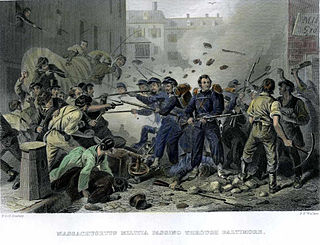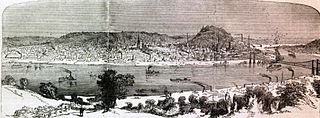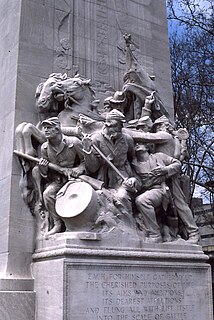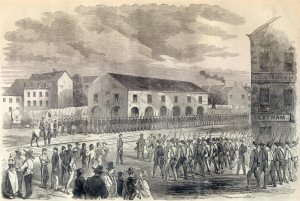 W
WThe city of Atlanta, Georgia, in Fulton County, was an important rail and commercial center during the American Civil War. Although relatively small in population, the city became a critical point of contention during the Atlanta Campaign in 1864 when a powerful Union Army approached from Union-held Tennessee. The fall of Atlanta was a critical point in the Civil War, giving the North more confidence, and leading to the re-election of President Abraham Lincoln and the eventual surrender of the Confederacy. The capture of the "Gate City of the South" was especially important for Lincoln as he was in a contentious election campaign against the Democratic opponent George B. McClellan.
 W
WThe Baltimore riot of 1861 was a civil conflict on Friday, April 19, 1861, on Pratt Street, in Baltimore, Maryland. It occurred between antiwar "Copperhead" Democrats and other Southern/Confederate sympathizers on one side, and on the other, members of Massachusetts and Pennsylvania state militia regiments en route to the national capital at Washington who had been called up for federal service. The fighting began at the President Street Station, spreading throughout President Street and subsequently to Howard Street, where it ended at the Camden Street Station. The riot produced the first deaths by hostile action in the American Civil War and is nicknamed the "First Bloodshed of the Civil War".
 W
WCharleston, South Carolina, was a hotbed of secession at the start of the American Civil War and an important Atlantic Ocean port city for the fledgling Confederate States of America. The first shots against the Federal government were those fired there by cadets of the Citadel to stop a ship from resupplying the Federally held Fort Sumter. Three months later, the bombardment of Fort Sumter triggered a massive call for Federal troops to put down the rebellion. Although the city and its surrounding fortifications were repeatedly targeted by the Union Army and Navy, Charleston did not fall to Federal forces until the last months of the war. Charleston was devastated.
 W
WDuring the American Civil War, the Ohio River port city of Cincinnati, Ohio, played a key role as a major source of supplies and troops for the Union Army. It also served as the headquarters for much of the war for the Department of the Ohio, which was charged with the defense of the region, as well as directing the army's offensives into Kentucky and Tennessee.
 W
WCleveland, Ohio was an important Northern city during the American Civil War. It provided thousands of troops to the Union Army, as well as millions of dollars in supplies, equipment, food, and support to the soldiers. The city was also an important national center for the abolitionist movement.
 W
WColumbia, the capital city of South Carolina, was an important political and supply center for the Confederate States Army during the American Civil War. Much of the town was destroyed during occupation by Union forces under Major General William T. Sherman during the Carolinas Campaign in the last months of the war. Sherman was accused almost immediately of having deliberately and needlessly burned the city, which he denied. Modern historians say that multiple causes were responsible.
 W
WThe History of Knoxville, Tennessee, began with the establishment of James White's Fort on the Trans-Appalachian frontier in 1786. The fort was chosen as the capital of the Southwest Territory in 1790, and the city, named for Secretary of War Henry Knox, was platted the following year. Knoxville became the first capital of the State of Tennessee in 1796, and grew steadily during the early 19th century as a way station for westward-bound migrants and as a commercial center for nearby mountain communities. The arrival of the railroad in the 1850s led to a boom in the city's population and commercial activity.
 W
WLexington, Kentucky was a city of importance during the American Civil War, with notable residents participating on both sides of the conflict. These included John C. Breckinridge, Confederate generals John Hunt Morgan and Basil W. Duke, and the Todd family, who mostly served the Confederacy although one, Mary Todd Lincoln, was the first lady of the United States, wife of President Abraham Lincoln.
 W
WLouisville in the American Civil War was a major stronghold of Union forces, which kept Kentucky firmly in the Union. It was the center of planning, supplies, recruiting and transportation for numerous campaigns, especially in the Western Theater. By the end of the war, Louisville had not been attacked once, although skirmishes and battles, including the battles of Perryville and Corydon, took place nearby.
 W
WMobile, Alabama during the American Civil War was an important port city on the Gulf of Mexico for the Confederate States of America. Mobile fell to the Union Army late in the war following successful attacks on the defenses of Mobile Bay by the Union Navy.
 W
WNew Orleans, Louisiana, was the largest city in the South, providing military supplies and thousands of troops for the Confederate States Army. Its location near the mouth of the Mississippi made it a prime target for the Union, both for controlling the huge waterway and crippling the Confederacy’s vital cotton exports.
 W
WNew York City during the American Civil War (1861–1865) was a bustling American city that provided a major source of troops, supplies, equipment and financing for the Union Army. Powerful New York politicians and newspaper editors helped shape public opinion toward the war effort and the policies of U.S. President Abraham Lincoln. The port of New York, a major entry point for immigrants, served as recruiting grounds for the Army. Irish-Americans and German-Americans participated in the war at a high rate.
 W
WPhiladelphia during the American Civil War was an important source of troops, money, weapons, medical care, and supplies for the Union.
 W
WPittsburgh, Pennsylvania was a thriving and important city during the American Civil War, and provided a significant source of personnel, war materiel, armament, ammunition, and supplies to the Union Army. Situated at the confluence of the Monongahela, Allegheny and Ohio rivers, Pittsburgh was an important transportation hub for both riverine and rail transport, as well as overland via its system of roads.
 W
WWilmington, North Carolina, was a major port for the Confederacy during the American Civil War. It was the last port to fall to the Union Army, completing its blockade of the Atlantic coast.
 W
WThe city of Winchester, Virginia, and the surrounding area, were the site of numerous battles during the American Civil War, as contending armies strove to control the lower Shenandoah Valley. Winchester changed hands more often than any other Confederate city.